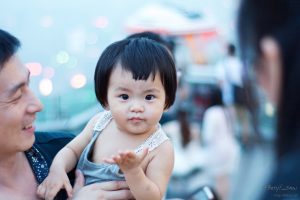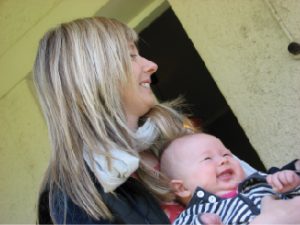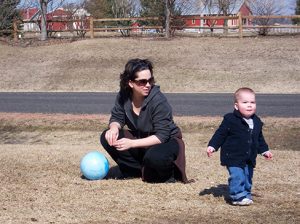2.11: 1950s: Harlow, Bowlby, and Ainsworth
- Page ID
- 77349
\( \newcommand{\vecs}[1]{\overset { \scriptstyle \rightharpoonup} {\mathbf{#1}} } \) \( \newcommand{\vecd}[1]{\overset{-\!-\!\rightharpoonup}{\vphantom{a}\smash {#1}}} \)\(\newcommand{\id}{\mathrm{id}}\) \( \newcommand{\Span}{\mathrm{span}}\) \( \newcommand{\kernel}{\mathrm{null}\,}\) \( \newcommand{\range}{\mathrm{range}\,}\) \( \newcommand{\RealPart}{\mathrm{Re}}\) \( \newcommand{\ImaginaryPart}{\mathrm{Im}}\) \( \newcommand{\Argument}{\mathrm{Arg}}\) \( \newcommand{\norm}[1]{\| #1 \|}\) \( \newcommand{\inner}[2]{\langle #1, #2 \rangle}\) \( \newcommand{\Span}{\mathrm{span}}\) \(\newcommand{\id}{\mathrm{id}}\) \( \newcommand{\Span}{\mathrm{span}}\) \( \newcommand{\kernel}{\mathrm{null}\,}\) \( \newcommand{\range}{\mathrm{range}\,}\) \( \newcommand{\RealPart}{\mathrm{Re}}\) \( \newcommand{\ImaginaryPart}{\mathrm{Im}}\) \( \newcommand{\Argument}{\mathrm{Arg}}\) \( \newcommand{\norm}[1]{\| #1 \|}\) \( \newcommand{\inner}[2]{\langle #1, #2 \rangle}\) \( \newcommand{\Span}{\mathrm{span}}\)\(\newcommand{\AA}{\unicode[.8,0]{x212B}}\)
Harlow and Bowlby: Attachment

Figure 1. A child comfortably rests in their parent’s arms. (Photo Credit: pxhere, CC0 1.0)
Mary Ainsworth

Figure 2. Mutually enjoyable interactions promote the mother-infant bond. (Image Credit: Peter Shanks)

Figure 3. In secure attachment, the parent provides a secure base for the toddler, allowing him to securely explore his environment. (Image Credit: Kerry Ceszyk)
- This chapter is an adaptation of Childhood by Lumen Learning, used under a CC BY 4.0 license. ↵
- Harlow, H. F. (1958). The nature of love. American Psychologist, 13(1), 673-685. ↵
- Bowlby, J. (1969). Attachment and loss, vol. 1: Attachment. Basic Books. ↵
- Bowlby, J. (1988). A secure base: Parent-child attachment and healthy human development. Basic Books. ↵
- Bowlby, J. (1969). Attachment and loss, vol. 1: Attachment. Basic Books. ↵
- Ainsworth, M. D. S., & Bell, S. M. (1970). Attachment, exploration, and separation: Illustrated by the behavior of one-year-olds in a strange situation. Child Development,41(1), 49-67. ↵
- Psychologist World. (2019). Attachment theory. https://www.psychologistworld.com/developmental/attachment-theory↵
- Ainsworth, M. D. S., & Bell, S. M. (1970). Attachment, exploration, and separation: Illustrated by the behavior of one-year-olds in a strange situation. Child Development, 41(1), 49-67. ↵
- Main, M., & Solomon, J. (1990). Procedures for identifying infants as disorganized/disoriented during the Ainsworth Strange Situation. In M. T. Greenberg, D. Cicchetti, & E. M. Cummings (Eds.), Attachment in the preschool years: Theory, research, and intervention (pp. 121-160). University of Chicago Press. ↵
- Ainsworth, M. D. S., Blehar, M. C., Waters, E., & Wall, S. (1978). Patterns of attachment: A psychological study of the Strange Situation. Erlbaum. ↵
- Ainsworth, M. D. S., & Bell, S. M. (1970). Attachment, exploration, and separation: Illustrated by the behavior of one-year-olds in a strange situation. Child Development, 41(1), 49-67. ↵
- Main, M., & Solomon, J. (1990). Procedures for identifying infants as disorganized/disoriented during the Ainsworth Strange Situation. In M. T. Greenberg, D. Cicchetti, & E. M. Cummings (Eds.), Attachment in the preschool years: Theory, research, and intervention (pp. 121-160). University of Chicago Press. ↵
- Gervai, J. (2009). Environmental and genetic influences on early attachment. Child and Adolescent Psychiatry and Mental Health, 3(1), 25. https://doi.org/10.1186/1753-2000-3-25↵
- Harris, J. R. (2009). Attachment theory underestimates the child. Behavioral and Brain Sciences, 32(1), 30. https://doi.org/10.1017/S0140525X09000119↵
- Van Ijzendoorn, M. H., & Sagi-Schwartz, A. (2008). Cross-cultural patterns of attachment: Universal and contextual dimensions. In J. Cassidy & P. R. Shaver (Eds.), Handbook of attachment: Theory, research and clinical applications (pp. 880–905). Guilford Press. ↵


